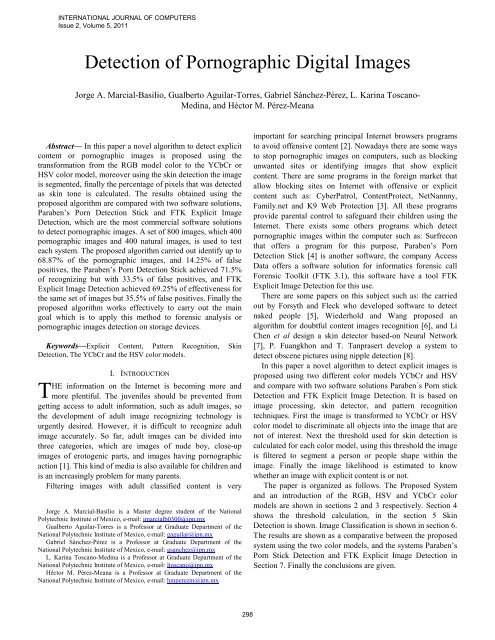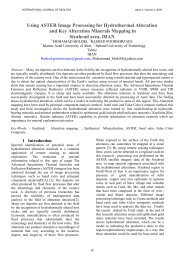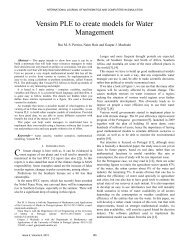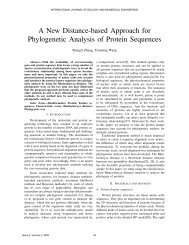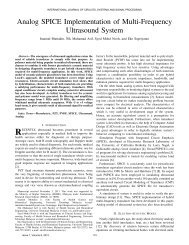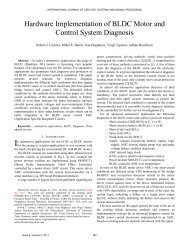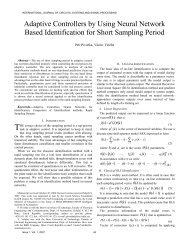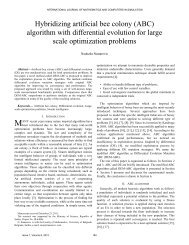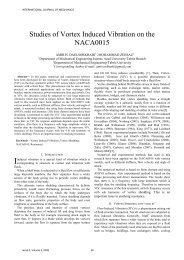Detection of Pornographic Digital Images - NAUN
Detection of Pornographic Digital Images - NAUN
Detection of Pornographic Digital Images - NAUN
Create successful ePaper yourself
Turn your PDF publications into a flip-book with our unique Google optimized e-Paper software.
INTERNATIONAL JOURNAL OF COMPUTERS<br />
Issue 2, Volume 5, 2011<br />
<strong>Detection</strong> <strong>of</strong> <strong>Pornographic</strong> <strong>Digital</strong> <strong>Images</strong><br />
Jorge A. Marcial-Basilio, Gualberto Aguilar-Torres, Gabriel Sánchez-Pérez, L. Karina Toscano-<br />
Medina, and Héctor M. Pérez-Meana<br />
Abstract— In this paper a novel algorithm to detect explicit<br />
content or pornographic images is proposed using the<br />
transformation from the RGB model color to the YCbCr or<br />
HSV color model, moreover using the skin detection the image<br />
is segmented, finally the percentage <strong>of</strong> pixels that was detected<br />
as skin tone is calculated. The results obtained using the<br />
proposed algorithm are compared with two s<strong>of</strong>tware solutions,<br />
Paraben’s Porn <strong>Detection</strong> Stick and FTK Explicit Image<br />
<strong>Detection</strong>, which are the most commercial s<strong>of</strong>tware solutions<br />
to detect pornographic images. A set <strong>of</strong> 800 images, which 400<br />
pornographic images and 400 natural images, is used to test<br />
each system. The proposed algorithm carried out identify up to<br />
68.87% <strong>of</strong> the pornographic images, and 14.25% <strong>of</strong> false<br />
positives, the Paraben’s Porn <strong>Detection</strong> Stick achieved 71.5%<br />
<strong>of</strong> recognizing but with 33.5% <strong>of</strong> false positives, and FTK<br />
Explicit Image <strong>Detection</strong> achieved 69.25% <strong>of</strong> effectiveness for<br />
the same set <strong>of</strong> images but 35.5% <strong>of</strong> false positives. Finally the<br />
proposed algorithm works effectively to carry out the main<br />
goal which is to apply this method to forensic analysis or<br />
pornographic images detection on storage devices.<br />
Keywords—Explicit Content, Pattern Recognition, Skin<br />
<strong>Detection</strong>, The YCbCr and the HSV color models.<br />
I. INTRODUCTION<br />
HE information on the Internet is becoming more and<br />
T more plentiful. The juveniles should be prevented from<br />
getting access to adult information, such as adult images, so<br />
the development <strong>of</strong> adult image recognizing technology is<br />
urgently desired. However, it is difficult to recognize adult<br />
image accurately. So far, adult images can be divided into<br />
three categories, which are images <strong>of</strong> nude boy, close-up<br />
images <strong>of</strong> erotogenic parts, and images having pornographic<br />
action [1]. This kind <strong>of</strong> media is also available for children and<br />
is an increasingly problem for many parents.<br />
Filtering images with adult classified content is very<br />
Jorge A. Marcial-Basilio is a Master degree student <strong>of</strong> the National<br />
Polytechnic Institute <strong>of</strong> Mexico, e-mail: jmarcialb0300@ipn.mx<br />
Gualberto Aguilar-Torres is a Pr<strong>of</strong>essor at Graduate Department <strong>of</strong> the<br />
National Polytechnic Institute <strong>of</strong> Mexico, e-mail: gaguilar@ipn.mx<br />
Gabriel Sánchez-Pérez is a Pr<strong>of</strong>essor at Graduate Department <strong>of</strong> the<br />
National Polytechnic Institute <strong>of</strong> Mexico, e-mail: gsanchez@ipn.mx<br />
L. Karina Toscano-Medina is a Pr<strong>of</strong>essor at Graduate Department <strong>of</strong> the<br />
National Polytechnic Institute <strong>of</strong> Mexico, e-mail: ltoscano@ipn.mx<br />
Héctor M. Pérez-Meana is a Pr<strong>of</strong>essor at Graduate Department <strong>of</strong> the<br />
National Polytechnic Institute <strong>of</strong> Mexico, e-mail: hmperezm@ipn.mx<br />
298<br />
important for searching principal Internet browsers programs<br />
to avoid <strong>of</strong>fensive content [2]. Nowadays there are some ways<br />
to stop pornographic images on computers, such as blocking<br />
unwanted sites or identifying images that show explicit<br />
content. There are some programs in the foreign market that<br />
allow blocking sites on Internet with <strong>of</strong>fensive or explicit<br />
content such as: CyberPatrol, ContentProtect, NetNannny,<br />
Family.net and K9 Web Protection [3]. All these programs<br />
provide parental control to safeguard their children using the<br />
Internet. There exists some others programs which detect<br />
pornographic images within the computer such as: Surfrecon<br />
that <strong>of</strong>fers a program for this purpose, Paraben’s Porn<br />
<strong>Detection</strong> Stick [4] is another s<strong>of</strong>tware, the company Access<br />
Data <strong>of</strong>fers a s<strong>of</strong>tware solution for informatics forensic call<br />
Forensic Toolkit (FTK 3.1), this s<strong>of</strong>tware have a tool FTK<br />
Explicit Image <strong>Detection</strong> for this use.<br />
There are some papers on this subject such as: the carried<br />
out by Forsyth and Fleck who developed s<strong>of</strong>tware to detect<br />
naked people [5], Wiederhold and Wang proposed an<br />
algorithm for doubtful content images recognition [6], and Li<br />
Chen et al design a skin detector based-on Neural Network<br />
[7], P. Fuangkhon and T. Tanprasert develop a system to<br />
detect obscene pictures using nipple detection [8].<br />
In this paper a novel algorithm to detect explicit images is<br />
proposed using two different color models YCbCr and HSV<br />
and compare with two s<strong>of</strong>tware solutions Paraben´s Porn stick<br />
<strong>Detection</strong> and FTK Explicit Image <strong>Detection</strong>. It is based on<br />
image processing, skin detector, and pattern recognition<br />
techniques. First the image is transformed to YCbCr or HSV<br />
color model to discriminate all objects into the image that are<br />
not <strong>of</strong> interest. Next the threshold used for skin detection is<br />
calculated for each color model, using this threshold the image<br />
is filtered to segment a person or people shape within the<br />
image. Finally the image likelihood is estimated to know<br />
whether an image with explicit content is or not.<br />
The paper is organized as follows. The Proposed System<br />
and an introduction <strong>of</strong> the RGB, HSV and YCbCr color<br />
models are shown in sections 2 and 3 respectively. Section 4<br />
shows the threshold calculation, in the section 5 Skin<br />
<strong>Detection</strong> is shown. Image Classification is shown in section 6.<br />
The results are shown as a comparative between the proposed<br />
system using the two color models, and the systems Paraben’s<br />
Porn Stick <strong>Detection</strong> and FTK Explicit Image <strong>Detection</strong> in<br />
Section 7. Finally the conclusions are given.
INTERNATIONAL JOURNAL OF COMPUTERS<br />
Issue 2, Volume 5, 2011<br />
II. PROPOSED SYSTEM<br />
The Figure 1 shows the proposed system, which has four<br />
stages: the image transformation from RGB to YCbCr, or HSV<br />
color model is done in the first stage. Filter stage is obtained<br />
using the skin detection with the proposed threshold. Next a<br />
Quantifier is used to count the number <strong>of</strong> skin pixels. Finally<br />
in the decision stage the images are classified by the<br />
percentage <strong>of</strong> skin that contains the image.<br />
Fig. 1 Proposed System<br />
To determine the threshold <strong>of</strong> our proposed system, a<br />
histogram analysis was performed. Figure 2 shows this<br />
stage.<br />
Fig. 2 Algorithm to Threshold Calculation<br />
A. The RGB Color Model<br />
III. COLOR MODELS<br />
The RGB color model is an additive color model in which<br />
the primary colors red, green, and blue light are added together<br />
in various ways to reproduce a broad array <strong>of</strong> colors. The<br />
name comes from the initials <strong>of</strong> the three colors Red, Green,<br />
and Blue. The RGB color model is shown in the Figure 3.<br />
Fig. 3 RGB Color Model<br />
The main purpose <strong>of</strong> the RGB color model is for sensing,<br />
representation, and display <strong>of</strong> images in electronic systems,<br />
such as televisions and computers.<br />
The RGB color model is an additive in the sense that three<br />
light beams are added together to make a final color. To form<br />
a color with RGB, three colored light beams (one red, one<br />
green, and one blue) should be superimposed. Each <strong>of</strong> the<br />
three beams is called a component <strong>of</strong> that color, and each can<br />
299<br />
have arbitrary intensity, from fully <strong>of</strong>f to fully on, in the<br />
mixture. Zero intensity for each component gives the darkest<br />
color (no light, considered the black), and full intensity <strong>of</strong> each<br />
gives a white.<br />
A color in the RGB color model is described by indicating<br />
how much <strong>of</strong> each <strong>of</strong> the red, green, and blue is included in<br />
each component which can vary from zero to a defined<br />
maximum value which depends <strong>of</strong> the application. In<br />
computing, the component values are <strong>of</strong>ten stored as integer<br />
numbers in the range 0 to 255.<br />
B. YCbC r Color Model<br />
The YCbCr color model is widely used in digital video,<br />
image processing, etc. In this format, luminance information is<br />
represented by a single component, Y, color information is<br />
stored as two color-difference components, Cb and Cr.<br />
Component Cb is the difference between the blue component<br />
and a reference value, and component and a reference value.<br />
The YCbCr color model was developed as part <strong>of</strong> ITU-R<br />
BT.601 during the development <strong>of</strong> a world-wide digital<br />
component video standard. YCbCr is a scaled and <strong>of</strong>fset<br />
version <strong>of</strong> the YUV color model. Y is the luma component<br />
defined to have a nominal 8-bit range <strong>of</strong> 16 – 235; Cb and Cr<br />
are the blue-difference and red-difference chroma components<br />
respectively, which are defined to have a nominal range <strong>of</strong> 16<br />
– 240.<br />
The transformation used to convert from RGB to YCbCr<br />
color space is shown in the equation (1):<br />
⎡Y<br />
⎤ ⎡16<br />
⎤ ⎡ 65.<br />
481<br />
⎢ ⎥ ⎢ ⎥<br />
+<br />
⎢<br />
⎢<br />
Cb<br />
⎥<br />
=<br />
⎢<br />
128<br />
⎥ ⎢<br />
− 37.<br />
797<br />
⎢⎣<br />
Cr ⎥⎦<br />
⎢⎣<br />
128⎥⎦<br />
⎢⎣<br />
112<br />
128.<br />
553<br />
−74.<br />
203<br />
− 93.<br />
786<br />
24.<br />
996 ⎤⎡R<br />
⎤<br />
112<br />
⎥⎢<br />
⎥<br />
⎥⎢<br />
G<br />
⎥<br />
− 18.<br />
214⎥⎦<br />
⎢⎣<br />
B⎥⎦<br />
The Figure 4 shows the transformation <strong>of</strong> the input image<br />
using the expression above.<br />
Fig. 4 Transformation from RGB to YCbCr color model<br />
C. HSV Color Model<br />
HSV color model (Hue, Saturation, and Value) is a no lineal<br />
transformation <strong>of</strong> the RGB color model, and the colors are the<br />
combination <strong>of</strong> the three values: the Hue (H), Saturation or<br />
color quantity (S), and itself value (V) [9]. These values are<br />
represented in a circular diagram, as shown in Figure 5.<br />
(1)
INTERNATIONAL JOURNAL OF COMPUTERS<br />
Issue 2, Volume 5, 2011<br />
Fig. 5 HSV Color Model<br />
The three magnitudes can have the following values:<br />
Hue: The type <strong>of</strong> color (e.g. red, green, or yellow). These<br />
are represented as a degree <strong>of</strong> angle whose possible values<br />
range from 0° to 360° (although for some applications are<br />
normalized from to 0 to 100%).<br />
Saturation: Is represented as a distance from the axis <strong>of</strong> the<br />
black-white glow. The possible values range from 0 to 100%.<br />
Value: Represents the height in the black-white axis. The<br />
possible values range from 0 to 100%. 0 is always black.<br />
Depending on the saturation, 100 could be white or a more or<br />
less saturated color.<br />
The transformation <strong>of</strong> an input image in RGB color model is<br />
achieved using the expressions (2) to (4) that are shown below.<br />
H = arccos<br />
1 [ ( R − G)<br />
+ ( R − B)<br />
]<br />
2<br />
2 ( R − G)<br />
+ ( R − B)(<br />
G − B)<br />
[ ]<br />
( R,<br />
G,<br />
B)<br />
min<br />
S = 1−<br />
3<br />
R + G + B<br />
1<br />
V = ( R + G + B)<br />
(4)<br />
3<br />
The Figure 6 is a sample <strong>of</strong> the conversion to the HSV color<br />
model <strong>of</strong> an image in RGB color model.<br />
Fig. 6 Transformation from RGB to HSV color model<br />
IV. THRESHOLD CALCULATION<br />
A. YCbCr Histogram Analysis<br />
In contrast to RGB, the YCbCr color model is lumaindependent,<br />
resulting in a better performance. The<br />
corresponding skin cluster is given as [10]:<br />
Y > 80<br />
85 < Cb < 135<br />
135 < Cr < 180,<br />
Where Y, Cb, Cr = [0, 255].<br />
(2)<br />
(3)<br />
300<br />
N. Sarris et al. [11] used only the chrominance components,<br />
Cb and Cr, to detect faces in color images, V. Neagoe and M.<br />
Neghhina [12] proposed a system to face detection using this<br />
color model.<br />
Chai and Ngan [13] have developed an algorithm that<br />
exploits the spatial characteristics <strong>of</strong> human skin color. A skin<br />
color map is derived and used on the chrominance components<br />
<strong>of</strong> the input image to detect pixels that appear to be skin.<br />
Working in this color model Chain and Ngan have found that<br />
range <strong>of</strong> Cb and Cr most representatives for the skin-color<br />
reference map are:<br />
77≤Cb≤127 and 133≤Cr≤173<br />
However due to that our purpose is to find human skin from<br />
different races, the thresholds given above works only with a<br />
Caucasian people skin because the first threshold only finds<br />
people with white skin, and the second threshold segments<br />
people <strong>of</strong> different places <strong>of</strong> the world but some pixels are<br />
detected as skin but really not. For this reason is proposed a<br />
new skin threshold to segment people within the image<br />
regardless skin color.<br />
A histogram analysis in the YCbCr color model <strong>of</strong> many<br />
images was necessary to determine the optimal threshold. The<br />
results expressed in Figure 7 and 8 shows the histograms<br />
values which help to decide the best possible threshold for<br />
different people who have different skin color.<br />
Fig. 7 White Skin Girl<br />
Fig. 8 Black Skin Man
INTERNATIONAL JOURNAL OF COMPUTERS<br />
Issue 2, Volume 5, 2011<br />
As observed in the images above, the luminance Y<br />
histogram is so different for both cases white and black skin<br />
because the pixel values are concentrated in opposite <strong>of</strong> the<br />
histogram, so only the Cb and Cr chrominance histograms are<br />
used to propose a new threshold which includes people with<br />
different skin color from white to black skin.<br />
After exhaustive image histogram analysis, the optimal<br />
range threshold was:<br />
80≤Cb≤120 and 133≤Cr≤173<br />
B. HSV Histogram Analysis<br />
I. Aldasouqui and M. Hassan [14] designed an algorithm to<br />
human face detection using this color model.<br />
A histogram analysis in the HSV color model was<br />
performed to determine the threshold. Figure 9 and 10 are<br />
images with white and black skin. These histograms were<br />
necessary to identify the values range for our purpose, i.e. to<br />
segment a person or people in one image.<br />
Fig. 9 White Skin Girl<br />
Fig. 10 Black Skin Girl<br />
The histograms observed previously show the values that<br />
have the images <strong>of</strong> people with different races. After an<br />
extensive analysis the threshold decided was the following:<br />
301<br />
0 < H < 0.25<br />
0.15 < S < 0.9<br />
0.2 < V < 0.95<br />
Where H,S, and V are in the range from 0 to 1.<br />
V. SKIN DETECTION<br />
Skin detection can help detect a human limb, torso, or face<br />
within a picture. Lately many methods <strong>of</strong> skin identification<br />
within a digital image have been developed. Skin color has<br />
proved to be a useful and robust method for face detection,<br />
localization and tracking. There have been a number <strong>of</strong><br />
researchers who have looked at using color information to<br />
detect skin. Jones and Regh [15] constructed a color model<br />
using histogram-learning techniques at RGB color model.<br />
Yang and Auhuja [16] estimated probability density function<br />
<strong>of</strong> human skin using a finite Gaussian mixture model whose<br />
parameters are estimated through the EM algorithm. There are<br />
other researchers who have developed papers about the<br />
different models <strong>of</strong> skin detection as Vezhnevets et al.[17]<br />
Kakumanu et al.[18], and Kelly et al.[19].<br />
Once the color transformation has been made, the next stage<br />
is to proceed to pixel detection with human skin. This was<br />
carried out by using the thresholds proposed in this paper,<br />
which works in different color models.<br />
The Table I show some example <strong>of</strong> the skin detection using<br />
the proposed thresholds for images <strong>of</strong> different races <strong>of</strong><br />
people.<br />
Table I Skin <strong>Detection</strong> using the proposed threshold to<br />
YCBCr color model<br />
Input Image YCbCr<br />
threshold
INTERNATIONAL JOURNAL OF COMPUTERS<br />
Issue 2, Volume 5, 2011<br />
In the Table I, can be observed that the proposed threshold<br />
to the YCbCr color model works efficiently in people with<br />
different skin color.<br />
Table II Skin <strong>Detection</strong> using the proposed threshold to<br />
HSV color model<br />
Input Image HSV threshold<br />
The Table II shows the segmentation in basis to human skin<br />
color using the proposed threshold to the HSV model color.<br />
This table contains some examples <strong>of</strong> people with white,<br />
brown and black skin, the proposed threshold works correctly.<br />
VI. IMAGE CLASSIFICATION<br />
To determine if the image has a explicit content or<br />
pornographic, the Skin Pixel Quantifier counts the pixels that<br />
the previous stage detect as skin color, then using (4) the skin<br />
percentage is calculated to know if the image have<br />
objectionable content.<br />
# skin color pixels<br />
skin percentage = x100<br />
(4)<br />
# image pixels in total<br />
To consider an image as explicit content or pornographic<br />
image, the skin percentage must be more than 50% or equal.<br />
The Table III shows some examples <strong>of</strong> the image classification<br />
using all the proposed system to classify the images.<br />
302<br />
Input Image<br />
Table III Image Classification<br />
Color<br />
Model<br />
YCbCr<br />
YCbCr<br />
YCbCr<br />
HSV<br />
HSV<br />
HSV<br />
<strong>Images</strong> Classification<br />
Proposed<br />
Classifier<br />
Skin<br />
Percentage<br />
60.64%<br />
56.36%<br />
2.39%<br />
75.55%<br />
28.17%<br />
39.35%<br />
In the Table III can be seen some examples using the two<br />
methods to detect explicit content or pornographic images.<br />
Skin detection can be used as the basis for detection <strong>of</strong> the<br />
images with explicit content because there is a considerable<br />
relationship between the images with large areas <strong>of</strong> skin and<br />
pornographic images or with explicit content.
INTERNATIONAL JOURNAL OF COMPUTERS<br />
Issue 2, Volume 5, 2011<br />
VII. RESULTS<br />
A test to see the performance <strong>of</strong> the proposed system was<br />
using different images from Internet. The system can process<br />
different kind <strong>of</strong> images, as images in different lighting<br />
conditions and images with different size.<br />
The input images for testing are classified in: a) images <strong>of</strong><br />
naked people or with explicit content and b) natural images. In<br />
the images <strong>of</strong> naked people Asians, Caucasians, Europeans,<br />
Latin Americans and a little amount <strong>of</strong> people with black skin<br />
can be found. A natural images one that by its nature does not<br />
contain explicit or pornographic content. In the set <strong>of</strong> natural<br />
images there are different kinds <strong>of</strong> images such as: dressed<br />
people, animals, plants, cars, cartoons, landscapes and others<br />
were also obtain from Internet.<br />
First the input image is converted from RGB model color to<br />
YCbCr or HSV color model. After this stage, skin detection is<br />
used to identify the areas that contain some skin tone, and in<br />
this way only get the image <strong>of</strong> the person or people within the<br />
input image.<br />
At this point, all skin areas detected are taken, and proceed<br />
to count the amount <strong>of</strong> pixels that there exists within the image<br />
to estimate the likelihood that this image is classified as an<br />
image with pornographic content or not.<br />
For this test, the set was used had 400 adult images which<br />
all are <strong>of</strong> naked people, and 400 natural images.<br />
Using the proposed system was obtained the following<br />
results that show in the Table IV:<br />
Table IV Results <strong>of</strong> Proposed system<br />
Color Model <strong>Pornographic</strong><br />
<strong>Images</strong><br />
Recognizing<br />
False<br />
Positives<br />
YCbCr 68.87 % 14.25 %<br />
HSV 68.25 % 18.25 %<br />
The Table IV shows the percentage <strong>of</strong> explicit content or<br />
pornographic images recognizing using the two methods which<br />
are using the proposed thresholds to skin detection.<br />
As mentioned in the section 1, there exists s<strong>of</strong>tware to detect<br />
explicit content images which are Paraben’s Porn <strong>Detection</strong><br />
Stick and FTK 3.1 Explicit Image <strong>Detection</strong> that are used to<br />
make a comparison between the proposed system and these<br />
s<strong>of</strong>tware solutions.<br />
Paraben’s Porn <strong>Detection</strong> Stick is a thumb drive device that<br />
will search through all the images on your computers, scan<br />
them for pornographic content, and create a report <strong>of</strong><br />
suspected pornographic images [4]. It works with s<strong>of</strong>tware that<br />
is within the USB device, only the user selects the sensitivity<br />
to start the search within the computer, the range <strong>of</strong> the<br />
sensitivity is the following: 0 Fewer False Positives to 100<br />
More False Positives; The images are classified in Highly<br />
Suspect, to compare the proposed system with this s<strong>of</strong>tware,<br />
three test was done using different thresholds for each<br />
303<br />
experiment. The results obtained are shown in the Table V.<br />
Table V Results obtained with Paraben’s Porn Stick<br />
<strong>Detection</strong><br />
2<br />
3<br />
Experiment Experiment Experiment<br />
Sensitivity 65 75 100<br />
Recognize<br />
False<br />
66.25 % 68.25% 71.50%<br />
Positives 23.25 % 28.75% 33.50%<br />
1 st<br />
Also s<strong>of</strong>tware was used from Access Data is called Forensic<br />
Toolkit 3.1 Explicit Image <strong>Detection</strong>, to make another<br />
comparison between the proposed system and its system to<br />
detect images. It makes a forensic image <strong>of</strong> the device that<br />
have to analyze, after the analysis began with three algorithms<br />
to determine the percentage <strong>of</strong> explicit content <strong>of</strong> an image.<br />
The description <strong>of</strong> the three algorithms used for evaluate the<br />
images was obtained from [20] and was shown in the Table<br />
VI.<br />
Table VI Explicit Image <strong>Detection</strong> Pr<strong>of</strong>ile Types<br />
Pr<strong>of</strong>ile<br />
Name<br />
Level Description<br />
X-DFT Default This is the most generally<br />
(XS1) accurate, it is always selected.<br />
X-FST Fast This is the fastest. It scores a<br />
(XTB) folder by the number <strong>of</strong> files it<br />
contains that meets the criteria for<br />
a high likelihood <strong>of</strong> explicit<br />
material.<br />
It is built on a different<br />
X-ZFN Less False<br />
technology than X-DFT and does<br />
not use “regular” DNAs. It is<br />
designed for very high volumes,<br />
or real-time page scoring. Its<br />
purpose is to quickly reduce, or<br />
filter, the volume <strong>of</strong> data to a<br />
meaningful set.<br />
This is a pr<strong>of</strong>ile similar to S-FST<br />
Negatives but with more features and with<br />
(XT2) fewer false negatives than X-<br />
DFT.<br />
Apply this filter after initial<br />
processing to all evidence, or to<br />
only the folders that score highly<br />
using the X-FST option. Checkmark<br />
or highlight those folders to<br />
isolate them for Additional<br />
Analysis.<br />
To test its system, the same set <strong>of</strong> input images was used<br />
using three pr<strong>of</strong>iles that have. Some examples <strong>of</strong> the results<br />
nd<br />
rd
INTERNATIONAL JOURNAL OF COMPUTERS<br />
Issue 2, Volume 5, 2011<br />
that were obtained using FTK Explicit Image <strong>Detection</strong> are<br />
shown in the Table VII.<br />
Table VII Results obtained with FTK 3.1<br />
Input Image Algorithms used<br />
X-FST X-DFT X-ZFN<br />
The Table VII shows the explicit content percentages <strong>of</strong> an<br />
image, knowing this the results <strong>of</strong> the recognizing are shown in<br />
the Table VIII. An image is considered as explicit content or<br />
pornographic image if two <strong>of</strong> the three algorithms result with<br />
more than 80.<br />
93<br />
99<br />
99<br />
11<br />
11<br />
21<br />
11<br />
42<br />
0<br />
11<br />
93<br />
99<br />
99<br />
11<br />
11<br />
304<br />
Table VIII Percentage <strong>of</strong> Recognizing<br />
Recognize False Positives<br />
69.25 % 35.50%<br />
Other test to prove the efficiency <strong>of</strong> the system, the system<br />
was proved using 100 pornographic images, and the results<br />
that was obtained, are shown in the Table IX.<br />
Table IX Results <strong>of</strong> False Negatives<br />
System<br />
Proposed System<br />
Recognize False Negatives<br />
HSV color model<br />
Paraben’s Porn<br />
76%<br />
24%<br />
<strong>Detection</strong> Stick<br />
FTK 3.1 Explicit<br />
86%<br />
14%<br />
Image <strong>Detection</strong> 74%<br />
26%<br />
VIII. CONCLUSION<br />
This paper proposed an algorithm to detect explicit content<br />
or pornographic in color images, using the YCbCr or HSV<br />
color model and a method <strong>of</strong> skin detection which works<br />
effectively although in some images it could find some errors,<br />
due to the image lighting conditions when was taken.<br />
The YCbCr and HSV color models are an important method<br />
to be able to decrease all the lighting problems that the image<br />
could be had; this is achieved using components <strong>of</strong><br />
chrominance Cb and Cr only for the YCbCr color model, in<br />
the case <strong>of</strong> the HSV color model, all the components are taken<br />
to decrease this problem.<br />
The importance <strong>of</strong> comparing the proposed system with the<br />
two s<strong>of</strong>tware solutions was done to know whether the<br />
proposed system could do the same work as the s<strong>of</strong>tware<br />
solutions <strong>of</strong>fer, and this way know whether the input image<br />
is a pornographic image or not, at final could prove that the<br />
proposed system carry out effectively, although the tools<br />
have a wide threshold that the proposed system. Even so the<br />
proposed system achieved a 76.25% and 77.75% to the<br />
YCbCr and HSV color model respectively, for explicit<br />
images detection.<br />
REFERENCES<br />
[1] Xiaoyin Wang; Changzhen Hu; Shuping Yao; “An Adult Image<br />
Recognizing Algorithm Based on Naked Body <strong>Detection</strong>”, Computing,<br />
Communication, Control, and Management 2009. (CCCM 2009).<br />
ISECS International Colloquium on, pp. 197 – 200, 2009.<br />
[2] Jorge A. Marcial Basilio, Gualberto Aguilar Torres, Gabriel Sánchez<br />
Pérez, L. Karina Toscano Medina, Héctor M. Pérez Meana, “Explicit<br />
Image <strong>Detection</strong> using YCbCr Space Color Model as Skin <strong>Detection</strong>”,<br />
In Proc. Of 5 th<br />
WSEAS Int. Conf. on Computer Engineering and<br />
Applications (CEA ‘11), pp. 123 – 128, 2011.<br />
[3] C. Habis, and F. Krsmanovic, “Explicit Image Filter,” Stanford Univ.,<br />
2005.<br />
[4] (2011) The Paraben’s Porn Stick <strong>Detection</strong> website. [Online]. Available:<br />
http://paraben-sticks.com/porn-detection-stick.html.
INTERNATIONAL JOURNAL OF COMPUTERS<br />
Issue 2, Volume 5, 2011<br />
[5] D. A. Forsyth. M. Fleek, and C. Bregler, “Finding naked people”,<br />
Proc.Forth European Conference on Computer Vision. pp 593-602,<br />
1996.<br />
[6] G. Wiederhold and J. Z. Wang, “WIPE (TM): Wavelet Image<br />
Pornography Elimination; A System for Screening Objectionable<br />
<strong>Images</strong>”.<br />
[7] Li Chen, J. Zhou, Z. Liu, W. Chen and G. Xiong, “A Skin Detector<br />
Based on Neural Network”, In IEEE 2002 International Conference on<br />
Communication, Circuits and Systems and West Sino Expositions, vol.<br />
1, 615 – 619, 2002.<br />
[8] P. Fuangkhon and T. Tanprasert, “Nipple <strong>Detection</strong> for Obscene<br />
Pictures”, In Proc. Of WSEAS Int. Conf. on Signal, Speech and Image<br />
Processing, pp. 315 – 320, 2005.<br />
[9] Jorge A. Marcial Basilio, Gualberto Aguilar Torres, Gabriel Sánchez<br />
Pérez, L. Karina Toscano Medina, Héctor M. Pérez Meana, and Enrique<br />
Escamilla Hernández, “Explicit Content Image <strong>Detection</strong>”, In Proc. Of<br />
Signal & Image Processing: An International Journal (SIPIJ) Vol. 1, No.<br />
2, pp. 61-72, 2010.<br />
[10] G. Kukharev, A. Novosielski, “Visitor identification elaborating real<br />
time face recognition system”, In Proc. 12 th<br />
Winter School on Computer<br />
Graphics (WSCG), Plzen, Czech Republic, pp. 157 – 164, Feb. 2004.<br />
[11] N. Sarris, N. Grammalidis, nd M. Strintzis, “<strong>Detection</strong> <strong>of</strong> Faces and<br />
Facial Features in <strong>Images</strong> using a Novel Neural Network Technique”, In<br />
Proc. Of WSEAS Int. Conf. on Neural Network and Applications, pp.<br />
6361-6366, 2001.<br />
[12] Victor-Emil Neagoe, Mihai Neghina, “Face <strong>Detection</strong> Using a Dual<br />
Cross-Validation <strong>of</strong> Chrominance/Luminance Channel Decisions and<br />
Decorrelation <strong>of</strong> the Color Space”, In Proc. Of 14 th<br />
WSEAS Int. Conf.<br />
on Computers, pp. 391-396, 2010.<br />
[13] D. Chai, and K.N. Ngan, "Face segmentation using skin-color map in<br />
videophone applications". IEEE Trans. on Circuits and Systems for<br />
Video Technology, 9(4): 551-564, June 1999.<br />
[14] Iyad Aldasouqi, and Mahmoud Hassan, “Human Face <strong>Detection</strong> System<br />
Using HSV”, In Proc. Of 9 th<br />
WSEAS Int. Conf. on Circuits, Systems.<br />
Electronics, Control & Signal Processing (CSECS’10), pp. 13-16, 2010.<br />
[15] M. J. Jones and J. M. Regh, “Statistical color models with application to<br />
skin detection”, In Proc. Of the CVPR ’99, vol. 1, 274-280, 1999.<br />
[16] M. H. Yang and N. Ahuja, “Detecting human faces in color images ”, In<br />
International Conference on Image Processing (ICIP), vol 1, 127-130,<br />
1998.<br />
[17] V. Vezhnevets, V. Sazonov, A. Andreeva, “A Survey on Pixel-based<br />
Skin Color <strong>Detection</strong> Techniques”, In Proceedings <strong>of</strong> the GrapiCon, 85-<br />
92, 2003.<br />
[18] P. Kakumanu, S. Makrogiannis, N. Bourbakis, “A survey <strong>of</strong> skin-color<br />
modeling and detection methods”, In Pattern Recognition, Vol. 40, pp.<br />
1106-1122, 2007.<br />
[19] W. Kelly, A. Donnellan and D. Molloy, “Screening for Objectionable<br />
<strong>Images</strong>: A Review <strong>of</strong> Skin <strong>Detection</strong> Techniques”, In Machine Vision<br />
and Image Processing Conference (IMVIP ‘08), 151 – 158, 2008.<br />
[20] FTK 3.1 User Guide.<br />
Jorge Alberto Marcial-Basilio received the BS degree on Electronic and<br />
Communications Engineer in 2009 from the National Polytechnic Institute <strong>of</strong><br />
Mexico. Actually he is a Master degree student at the Mechanical and<br />
Electrical Engineering School <strong>of</strong> the National Polytechnic Institute <strong>of</strong> Mexico.<br />
Gualberto Aguilar-Torres received the BS degree on Electronic and<br />
Communications Engineer; and The MS degree on Microelectronic<br />
Engineering, in 2003 and 2005, respectively, from the National Polytechnic<br />
Institute <strong>of</strong>, Mexico. In 2005 he received the Best Thesis award from the<br />
National Polytechnic Institute <strong>of</strong> Mexico for his Master research work and a<br />
member <strong>of</strong> the National Researchers System <strong>of</strong> Mexico.<br />
Gabriel Sanchez-Perez received the BS degree on Computer Science<br />
Engineer; and the PhD degree on Electronic and Communications, in 1999<br />
and 2005, respectively, from the National Polytechnic Institute, Mexico City.<br />
From January 2001 to October 2006 he joined the Computer Engineering<br />
Department Electrical and Mechanical Engineering School at the National<br />
Polytechnic Institute as Assistant Pr<strong>of</strong>essor. In October 2006 he joints the<br />
Graduate School <strong>of</strong> the National Polytechnic Institute <strong>of</strong> Mexico where he is<br />
now a Pr<strong>of</strong>essor. Pr<strong>of</strong>. Sanchez-Perez is a member <strong>of</strong> the IEEE.<br />
305<br />
Linda Karina Toscano-Medina received the BS degree on Computer<br />
Science Engineer; and the PhD degree on Electronic and Communications, in<br />
1999 and 2005, respectively, from the National Polytechnic Institute, Mexico<br />
City. From January 2003 to October 2007 she joined the Computer<br />
Engineering Department Electrical and Mechanical Engineering School at the<br />
National Polytechnic Institute as Assistant Pr<strong>of</strong>essor. In October 2007 she<br />
joints the Graduate School <strong>of</strong> the National Polytechnic Institute <strong>of</strong> Mexico<br />
where she is now a Pr<strong>of</strong>essor. Pr<strong>of</strong>. Toscano Medina is a member <strong>of</strong> the<br />
National Researchers System <strong>of</strong> Mexico.<br />
Hector M. Perez-Meana received the BS Degree in Electronics Engineers<br />
from the Universidad Autonoma Metropolitana (UAM) Mexico City in 1981,<br />
the M.S. degree from the University <strong>of</strong> Electro-Communications, Tokyo<br />
Japan in March 1986, and a Ph. D. degree in Electrical Engineering from<br />
Tokyo Institute <strong>of</strong> Technology, Tokyo, Japan, in 1989. In 1981 he joined the<br />
Electrical Engineering Department <strong>of</strong> the Metropolitan University where he<br />
was a Pr<strong>of</strong>essor. From March 1989 to September 1991, he was a visiting<br />
researcher at Fujitsu Laboratories Ltd, Kawasaki, Japan. In February 1997, he<br />
joined the Graduate Department <strong>of</strong> The Mechanical and Electrical<br />
Engineering School on the National Polytechnic Institute <strong>of</strong> Mexico, where he<br />
is now a Pr<strong>of</strong>essor. In 1991 Pr<strong>of</strong>. Perez-Meana received the IEICE excellent<br />
Paper Award, and in 1999 and 2000 the IPN Research Award. In 1998<br />
Pr<strong>of</strong>.Perez-Meana was Co-Chair <strong>of</strong> the ISITA’98. His principal research<br />
interests are signal and image processing, pattern recognition, watermarking,<br />
steganography and related fields. Dr. Perez-Meana is a senior member <strong>of</strong> the<br />
IEEE, a member <strong>of</strong> the IEICE, the IET, the National Researchers System <strong>of</strong><br />
Mexico and the Mexican Academy <strong>of</strong> Science.


